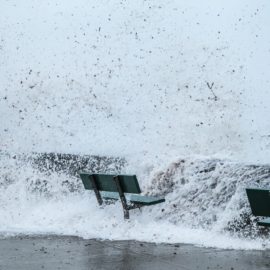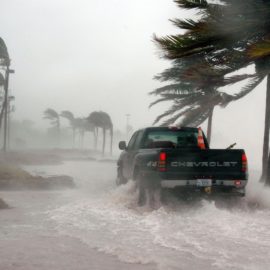
Wiklk the West Bank levees hold back the expected surge now that Ida is a category 4 storm and growing?
Hurricane Ida could bring up to 15 feet of storm surge to parts of the west bank of Jefferson Parish, threatening to push water over the tops of the levees that shield those areas. If that National Hurricane Center forecast proves true, it would be the first time the levees have been overtopped since the post-Hurricane Katrina upgrades to the system that surrounds much of the metro area. But officials said while some localized flooding is possible and urged residents to take precautions, they also stressed that the new barriers are designed for exactly this scenario and are expected to be able to withstand the onslaught.
nola.com
These fears go back to Katrina but it is a different system now. This is the first real test.
Sixteen years ago on Sunday, Katrina swept ashore carrying a deadly storm surge that toppled parts of the New Orleans-area levee system. But the $14.5 billion collection of levees, floodwalls, pumps and gates that has replaced it and now rings parts of New Orleans, Jefferson and St. Bernard parishes represents a radical improvement over the area’s previous protections. While critics and some government officials have called for higher and more substantial barriers than have been built in recent years, officials with the U.S. Army Corps of Engineers, levee authorities and local governments said that the levee system is capable of handling the expected surge that the New Orleans area will see from Ida. “This is a very differently protected city than it was 16 years ago” said Ramsey Green, New Orleans Mayor LaToya Cantrell’s deputy chief administrative officer for infrastructure.
New? Different? In what ways and will we still be protected?
Built into the new system is the idea that the levees would reduce the risk of a storm surge – not provide an impossible-to-guarantee level of unlimited protection – and that even when overmatched with high water, the system’s levees would still be left standing. “People need to know if they’re in an area that could get this surge, they need to be prepared, they need to understand that this is exactly what this system was designed to do,” said Ricky Boyett, a spokesperson for the U.S. Army Corps of Engineers in New Orleans. The levees’ height is aimed at blocking overtopping from water levels that have a 1 percent chance of occurring in any year, a so-called 100-year event. Worst-case surge created by a Category 4 hurricane striking the area around New Orleans would be greater than such an event. That could be tested for the first time this weekend.
How bad is it supposed to be? What can we expect from Ida?
Current forecasts from the National Hurricane Center — based on plausible worst case scenarios — say that between 10 feet and 15 feet of storm surge strike the coast of West Bank. The upper ends of that range would be higher than most Army Corps levees facing southwest in that area. That surge would be weakened as it moved over the marshes and land of southern Jefferson Parish, likely shrinking in height and intensity as it moved further inland and toward the levees surrounding the communities near the Mississippi River. Exactly how much of an effect that would have, however, is not clear. The average height of those levees is less than 14 feet, meaning that if the surge reached that far several feet of water could potentially make it over the top during the height of the storm. That water would be pumped out by the same systems that would handle rain from the storm. A key element in the design of the current levees is what’s known as “armoring,” which largely consists of grass and mats along the protected side of the levees. Those materials try to prevent any water that runs over the top of the levees from eroding their soil as it runs down their protected side. Without that protection, the water can wash away so much dirt that the levee collapses. “It’s a different system than we had in Katrina. By it being designed to be overtopped, we won’t have the erosion and the scouring that leads to breaching,” Boyett said. “Once that water recedes you’ll still have a levee there. There’s a big difference between a breach where water is running uncontrolled into an area and water coming over the top for a brief period of time.”
There is confidence in the system as we await the test.
Southeast Flood Protection Authority – West Region Director Nicholas Calli, whose agency oversees the levees, said he had confidence the system would work as designed. “Our levee system was designed to handle these types of events and have just recently been lifted and armored,” Cali said. “We are confident in the system’s abilities to weather Ida as intended for such an intense storm.” It’s not clear exactly how much water will make it through the marshy expanses separating the gulf from the levees. And if overtopping occurs, it’s not clear how much water will make it into the protected side of the system. Because the levees have never been overtopped, the system has never been tested in the real world. But extensive studies, conducted at Colorado State University before the armoring was approved, showed that the material now planted on the levees would be enough to keep them standing in a storm with a 0.2% chance of occurring in any year.
As a whole, the system is expected to hold and do what it is designed to to – protect us.
The rest of the levee system is expected to make it through the storm without significant problems, based on Ida’s current forecast track and intensity predictions. The flood protection authorities on either bank spent Saturday buttoning up the flood gates that dot the system. By the time Ida arrives, the entire network will be closed for the first time since Hurricane Barry in 2019. The storm surge predicted for Lake Pontchartrain and the East Bank of New Orleans top out at 7 to 11 feet. The East Bank levees and floodwalls range from between about 18 feet to nearly 30 feet high. The system includes 350 miles of levees and floodwalls as well as a series of large pumps and gates aimed at reducing the risk of flooding in the New Orleans area during hurricanes. The system is designed to block storm surge that has a 1% or higher chance of occurring each year.
The system also includes pumps which will be used.
The West Bank authority expects to use the West Closure Complex, the largest pump station in the world, during Ida. This will be the first time the station has been used since Hurricane Barry in 2019. At this point, the three large pumps on New Orleans’ outfall canals into Lake Pontchartrain are not expected to be needed. Those pumps are only required when surge pushes enough water into the lake that gate closures are needed to prevent water from flooding into the city’s outflow canals, something that is not currently predicted.
We will see as it is raining now as the storm approaches. Trial by fire is a saying that fits!



